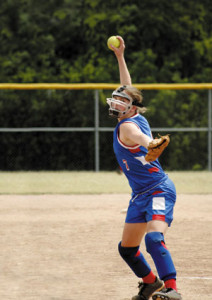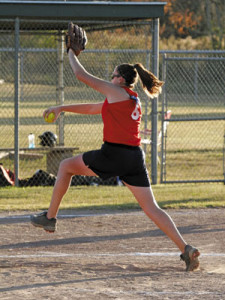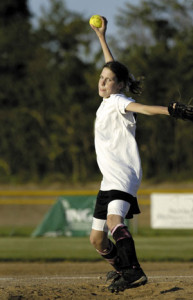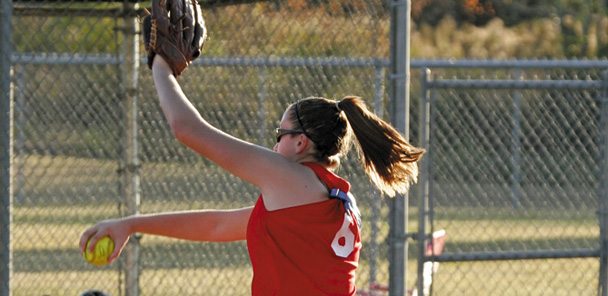
shutterstock.com #3357710
Injuries in softball pitchers typically occur in the upper extremities, but focusing rehabilitation and prevention efforts on the upper body alone ignores the essential supporting roles played by the pelvis and lower extremities in providing a stable base for the pitching motion.
By Gretchen D. Oliver, PhD, ATC, LAT
The sport of fast-pitch softball has become one of the most popular team sports for female athletes in the U.S.1 The medical literature is limited concerning the proper mechanics of pitching and mechanisms of injury prevention, with most of the focus on the mechanics of the pitch2-8 and minimal research on injury.9-11 Typically pitching injuries are sustained to the upper extremity, and emphasis has often been on conditioning the upper extremity for injury prevention. However, the true driving force of the windmill softball pitch is not the shoulder, it is the lower body.
When analyzing the windmill softball pitch, it is often split into different movement phases identified by the position of the throwing arm. As Maffett3 has described, Phase 1 is the windup to 6 o’clock; Phase 2 from 6 o’clock to 3 o’clock; Phase 3 from 3 o’clock to 12 o’clock; Phase 4 from 12 o’clock to 9 o’clock; and Phase 5 from 9 o’clock to ball release.

istockphoto.com #7437156
The windup phase in both softball and baseball is a preparatory movement for the pitching motion. The windup, as defined by both baseball and softball pitching, is the beginning of the movement and ends at a particular point that initiates the start of the pitching motion. In baseball pitching the windup is terminated at maximum knee lift, while in softball the termination is when the arm is at the 6 o’clock position.
Phases 2 and 3 of the softball pitching motion are similar to the stride phase in baseball pitching. In Phase 2, the pitcher has her body weight on the ipsilateral leg while she is striding out, squaring her trunk to the batter and elevating the arm to 90°. In Phase 3, she is transferring her body weight forward while the trunk is opening up, the arm is approaching 180° (12 o’clock position) and there is stride foot contact.
Phases 4 and 5 are considered the acceleration phase. Maximum external rotation of the shoulder defines the start of the acceleration phase in baseball pitching; in softball, the position comparable to maximum external rotation is the 12 o’clock position.
It has been reported that for each of the last four phases of the windmill softball pitch, the gluteal and scapular stabilizing muscles are highly activated.12 Understanding the role of the gluteal muscle group in stabilizing the pelvis, and the need for a stable pelvis to provide adequate scapular control, requires an understanding of how the lower extremity is the driving force of the windmill softball pitch.
Commonly reported injuries

istockphoto.com #2558510
Historically, windmill softball pitching injuries have been concentrated in the upper extremities, though the focus of injury prevention has evolved to the lower extremities. Previous studies have analyzed data on injuries sustained by windmill softball pitchers.9,10 In a 2004 survey-based study, 180 collegiate level windmill softball pitchers reported 131 injuries in the previous year. Out of the 131 injuries, 92 were overuse, with only 17 of those injuries occurring to the lower extremity.9 Prior to the 2004 study, Loosli and colleagues10 surveyed eight collegiate softball teams that ranked in the NCAA top 15 during the 1989 NCAA tournament. Twenty-six injuries were reported in 20 of 24 pitchers, with six of those injuries resulting in altered play and five leading to play stoppage.10 Of all the time-loss injuries reported in that study, 82% were overuse in nature.
The majority of overuse pitching injuries have occurred at the shoulder and elbow of windmill softball pitchers. Still, the pathomechanics that result in these upper extremity injuries are not always focused at the injury site. As previously stated, the lower body has to support the mechanics of the upper body. If the structures of the lower body, which for the purposes of this discussion will be considered proximal segments, cannot support the mechanics of the upper body, or distal segments, then the weakest link will be sacrificed. Though most windmill softball pitching injuries occur to the upper extremity and the shoulder is an area of emphasis for strengthening and conditioning in softball pitchers, it is truly the weakest link of the entire pitching motion. The strength of the shoulder has to be supported by the strength of the lower extremities.
Motor pattern sequencing
In analysis of the windmill softball pitch, motor patterns have been described as sequential in nature.8 It has been proposed that in baseball pitching, the more stable proximal segments are the driving force for the more dynamic distal segments.13 The same concepts can be applied to the windmill softball pitch. The proximal segments of the pelvis and torso work succinctly in an attempt to accelerate the distal segments of the upper extremity in a sequential manner.8,13 For the windmill softball pitcher, the analogous proximal segment is the area of the lumbopelvic-hip complex. Essentially, within the lumbopelvic-hip complex, the gluteal musculature is defined as the most proximal, then the pelvis, and then the torso, with the hand as the most distal segment.
Previous work describing segmental sequentiality,8,14 suggests that ball velocity, as it is transferred from the hand, is dependent upon the transfer of energy generated by the gluteal muscle group. Thus, appropriate segmental sequencing during the windmill softball pitch is initiated by the gluteal muscle group, which establishes the position of the pelvis. The pelvis can then position the torso, and then the scapula can position the humerus. This segmental sequencing will ultimately result in the dynamic positioning of the hand for ball release.
Importance of gluteal activation
For normal voluntary movement of the shoulder, it is necessary for the lower extremity to be activated prior to any upper extremity movement; this is the premise of the natural neuromuscular loop of the body.15,16 Muscle groups must work in a synergistic fashion and typically in a proximal-to-distal sequence when performing a dynamic movement such as the windmill softball pitch.15,16 This need for synergistic muscle activation dictates that the gluteal muscles (proximal muscles) be activated prior to activation of the trunk musculature and, in turn, the scapular stabilizers (next distal muscles), as required for functional and efficient shoulder movement. In this synergistic pattern of muscle activation, the lower extremity drives the position of the pelvis, torso, scapula, and shoulder during the pitching motion.
Baseball studies have suggested that the pelvis is the platform for the scapula, and the scapula is the platform for the shoulder.17 It is the muscle activation of the gluteals that directs the position of the pelvis, which in turn dictates the position of the trunk. Proper pelvis and trunk positioning allows for a stable and efficient scapula. Efforts to attain full humeral elevation require the scapula to be retracted. Scapular retraction is stimulated by ipsilateral hip extension and trunk extension. This lower extremity activation of the ipsilateral hip extensors ultimately results in the proper scapula position for overhead activities.
During the motion of the windmill softball pitch, full arm elevation is essential. During Phase 3, the throwing arm is approaching 180° of forward flexion in the 12 o’clock position. In order to achieve this position and facilitate normal dynamics throughout the windmill softball pitch, the shoulder must be stable. This shoulder stability relies on the stability of more proximal segments, just as it affects the stability of more distal segments. The stability of the glenohumeral joint depends on the stable platform of the scapula, and the stable platform for the scapula is the pelvis. If the pelvis does not provide a stable base, there will be inefficient energy transfer up the kinetic chain and the scapula will not be able to maintain stability.
In constant repetitive overhead activities associated with overuse injury, such as pitching, a stable scapula is vital for optimal rotator cuff function. The main purpose of the rotator cuff is to depress the humerus. If the scapula is not stable, then the rotator cuff will not be able to keep the humeral head depressed, which in turn will result in the humerus migrating superiorly, increasing the risk of impingement and other overuse injuries.
Lower extremity

istockphoto.com #484766
The principle of the neuromuscular loop dictates that voluntary movement is initiated in the lower extremities prior to the movement of the upper extremity.15,16,18 It has been established that the lower extremity is the driving force of the windmill softball pitch. It is important to understand the muscle activations throughout the pitching motion, since the performance outcome is highly dependent on the lower body.
As Oliver et al12 described, the gluteal muscle group is highly active during the dynamic movements of the windmill softball pitch. It has been shown that during the stride phase, the gluteal muscle group acts to stabilize the pelvis during single leg support.12 Pelvic stabilization during the single leg support component of the stride phase allows for efficient energy transfer from the proximal to distal segments of the kinetic chain. In addition, Kibler19 has stated that 51% to 55% of the total kinetic energy of the upper extremity during overhead movements is supplied by the trunk and legs. This notion of the lower extremity driving the upper extremity can be applied to all dynamic overhead activities. The energy should be generated proximally (lower extremity) and sequentially transferred distally (upper extremity) for movement efficiency.14 These studies support the concept that the dynamic movement occurring during the windmill softball pitch ultimately follows the principle of the neuromuscular loop.
Clinically, practitioners typically assumed that the gluteal muscle group is strong and adequately stabilizes the pelvis. However, when a total body clinical assessment is performed in a softball pitcher who has sustained an overuse injury to the upper extremity, it is almost guaranteed that the individual will display a lack of pelvic stability, which will be evident in weakness of the lumbopelvic-hip complex, as well as decreased scapular stability. Thus, rehabilitation of the overuse injury and prevention of future injuries has to begin proximally at the pelvis before progressing to the scapula. This interventional approach will not only decrease injury propensity but will also improve pitching performance.
Rehabilitation and strengthening
The focus of strength and conditioning as well as injury prevention should be to incorporate the entire kinetic chain. Typically, when strengthening or rehabilitating, the clinician focuses on treatment of the involved structures at the site of weakness or pain. In the case of a windmill softball pitcher, the focus is typically on the shoulder and upper extremity, given that the majority of pitching injuries have occurred to the upper extremity. However, based on normal motor patterns of voluntary movement, all conditioning should be initiated at the proximal aspect of the kinetic chain and coordinated sequentially throughout the distal aspect of the kinetic chain.
The focus should be on both pelvic and scapular stability. The hip and pelvis are the functional centerpiece, and the position of the pelvis drives the hip in serving as the platform for the scapula and shoulder. As stated earlier, if the pelvis is not stable then the scapula cannot achieve optimal stability, limiting the functionality of the glenohumeral joint. Based on normal motor patterns, full arm elevation to the 12 o’clock position requires ipsilateral hip and thoracic extension. This hip extension occurs during Phases 2 and 3, when the pitcher is striding out. It is important that the stride is initiated by the gluteal muscle group in attempt to allow for pelvic stability during this dynamic movement.
When considering training regimens for windmill softball pitchers, much of the conditioning should focus on strengthening the lower extremity and lumbopelvic-hip complex. The lower extremities and lumbopelvic-hip musculature can often be addressed in the same exercises. Ideally, the lumbopelvic-hip complex should be addressed first in the training cycle in order to maintain a base of stability throughout all the conditioning exercises.
When the athlete is performing other conditioning exercises, the athlete should maintain a pelvic neutral position. Pelvic neutral is the natural anatomical positioning of the pelvis. To obtain pelvic neutral, the abdominal muscles must be activated so that the pelvis is in line with the spine. Instructing the athlete to draw in her stomach and stand up straight will allow her to feel the position of pelvic neutral.
Once the athlete is in pelvic neutral, exercises focusing on the proximal and distal segments can be initiated. Maintaining pelvic neutral while improving gluteal muscle strength will allow the athlete to achieve greater pelvic and hip range of motion; this could ultimately lead to increased stride length during the pitching motion. It has also been shown that increased stride lengths in windmill softball pitching often lead to increased ball velocities.20 Therefore, strength and conditioning should primarily focus on the anatomical positioning of the lumbopelvic-hip complex as well as dynamic gluteal extension.21
Conclusion
As participation in fast pitch softball continues to increase, so will the number of injuries. So, given the increasing popularity of fast pitch softball, especially among youth athletes, understanding the driving force underlying pitching mechanics is paramount. Injury prevention and optimal performance depend on identifying the importance of the lower extremity, specifically the gluteal and lumbopelvic-hip complex muscle groups, and their contribution to the overall pitch mechanics early in a windmill softball pitcher’s career. The player with inadequate lower body support will eventually display compensatory pathomechanics in an attempt to overcome the rigors of the game, and serious injury can result. By addressing correct mechanics of the lower extremity through strength and conditioning programs, with a focus on neuromuscular control of the gluteal and lumbopelvic-hip complex as well as sequential sequencing of the entire kinetic chain, overuse injuries can be prevented.
Gretchen D. Oliver, PhD, ATC, LAT, is the clinical coordinator of the entry-level Graduate Athletic Training Education Program and an assistant professor in the Department of Health, Kinesiology, Recreation, and Dance at the University of Arkansas in Fayetteville.
References
1. Werner SL, Guido JA, McNeice RP, et al. Biomechanics of youth windmill softball pitching. Am J Sports Med 2005;33(4):552-560.
2. Barrentine SW, Fleisig GS, Whiteside JA, et al. Biomechanics of windmill softball pitching with implications about injury mechanisms at the shoulder and elbow. J Orthop Sports Phys Ther 1996;26(6):405-415.
3. Maffet MW, Jobe FW, Pink MM, et al. Shoulder muscle firing patterns during the windmill softball pitch. Am J Sports Med 1997;25(3):369-374.
4. Werner SL, Jones DG, Duido JA, Brunet ME. Kinematics and kinematics of elite windmill softball pitching. Am J Sports Med 2006;34(4):597-603.
5. Rojas IL, Provencher MT, Bhatia S, et al. Biceps activity during windmill softball pitching. Am J Sports Med 2009;37(3):558-566.
6. Guido JA, Werner SL, Meister K. Lower extremity ground reaction forces in youth windmill softball pitchers. J Strength Cond Res 2009;23(6):1873-1876.
7. Werner SL, Guido JA, McNeice RP, et al. Biomechanics of youth windmill softball pitching. Am J Sports Med 2005;33(4):552-560.
8. Oliver GD, Dwelly PM, Kwon Y-H. Kinematic motion of the windmill softball pitch in prepubescent and pubescent girls. J Strength Cond Res 2010;24(9):2400-2407.
9. Hill JL, Humphries B, Weidner T, Newton RU. Female collegiate windmill pitchers: influences to injury incidence. J Strength Cond Res 2004;18(3):426-431.
10. Loosli AR, Requa RK, Garrick JG, Hanley E. Injuries to pitchers in women’s collegiate fast-pitch softball. Am J Sports Med 1992;20(1):35-37.
11. Oliver GD. The windmill softball pitch: optimal mechanics and pathomechanics of injury. Athl Ther Today 2010;15(6):28-31.
12. Oliver GD, Plummer HP, Keeley DW. Muscle activation patterns of the upper and lower extremity during the windmill softball pitch. J Strength Cond Res 2011;25(6):1653-1658.
13. Pappas AM, Zawacki RM, Sullivan TJ. Biomechanics of baseball pitching. A preliminary report. Am J Sports Med 1985;13(4):216-222.
14. Putnam CA. Sequential motions of body segments in striking and throwing skills. J Biomech 1993;26(Suppl 1):125-135.
15. Cordo PJ, Nashner LM. Properties of postural adjustments associated with rapid arm movements. J Neurophysiol 1982;47(2):287-308.
16. Zattara M, Bouisset S. Posturo-kinetic organisation during the early phase of voluntary upper limb movement. 1. Normal subjects. J Neurol Neurosurg Psychiatry 1988;51(7):956-965.
17. Burkhard SS, Morgan CD, Kibler WB. The disabled throwing shoulder: Spectrum of pathology. Part I: Pathoanatomy and biomechanics. Arthoscopy 2003;12(4):404-420.
18. McMullen J, Uhl TL. A kinetic chain approach for shoulder rehabilitation. J Athl Train 2000;35(3):329-337.
19. Kibler WB. Biomechanical analysis of the shoulder during tennis activities. Clin Sports Med 1995;14(1):79-85.
20. Guido JA, Werner SL, Meister K. Lower-extremity ground reaction forces in youth windmill softball pitchers. J Strength Cond Res 2009;23(6):1873-1876.
21. Oliver GD. The windmill softball pitch, part 2: Injury prevention. Athl Ther Today 2011;16(1):27-31.










Does anyone know a exercise program to address the plevic and scapula stability for a softball pitcher
I have always taught a pitching regimen that requires proper opening and closing of the torso and use of the proximal to distal concept of the lower body on out to the hands. I would further argue that it starts at the pitching plate with the feet and works through the hips as they transfer the power to the upper body. I am disturbed that so many coaches across the country teach techniques that bypass the hips and torso and leave the body open so to speak at release ..causing considerable stress at some point to the elbows and shoulders. My personal experience transcends this sport and goes back almost 50 years. I was a collegiate discus and shot putter, and baseball pitcher as well. I have taught windmill pitching for 24 years or so. Proper sequencing of the windmill technique has always been part of my routine with young pitchers and old. From the very beginning clinic I work through a series of drills that teach the sequences. I have had continued success with a training program which includes pitching mechanics against a vertical surface, ie..a wall or a fence, or a sheet hanging or net. On my website, are photos of the inside of our facility showing yellow softballs painted on the walls where these drills are practiced. By training the body literally within inches of the vertical surface, I have found that it trains the body to use an upright, proper position in all phases of the arm swing and pitch. It is done in drills broken down by sequence or in total circles. The vertical wall will not allow the student to cheat and forces the posture nature intended. Otherwise, the student “bumps’ the wall and gets immediate feedback. I have always called it” shadow wall pitching,” analogous to shadow boxing.
I am encouraged to see this type of scientific discussion that supports lower body and torso rotation. I would love to learn more of your conclusions, if anyone reads this . Thank you. Bobby Waterbury, Pitching Instructor and owner of Waterbury’ s Fastpitch.